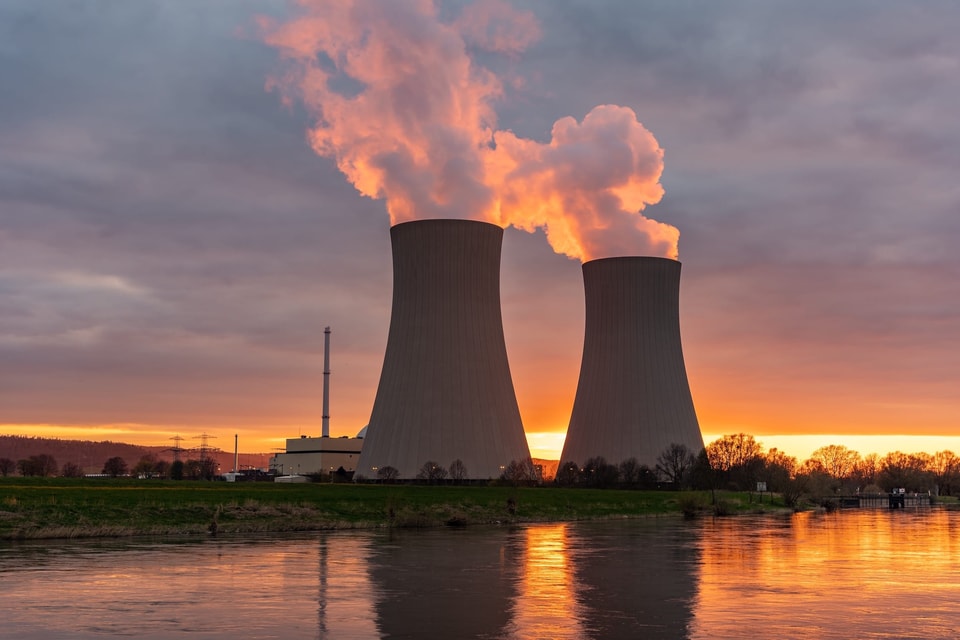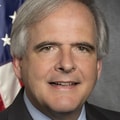Memo Published July 31, 2025 · 11 minute read
Trump is Gutting the NRC. Nuclear Deployment Will Face the Consequences.
Stephen Burns, Alan Ahn, Rowen Price, & Ryan Norman

The Nuclear Regulatory Commission (NRC)—the independent agency tasked with regulating the civilian use of nuclear materials and facilities—plays an essential role in the growth of nuclear energy. A credible NRC is necessary to maintain the public’s trust in nuclear power, and an efficient NRC is essential to enabling nuclear power to meet growing demand for clean, reliable power. Third Way has long supported efforts to reform and modernize the NRC. We believe in the need to rapidly scale nuclear deployment in the United States, and are confident that the NRC can increase efficiency without compromising safety.
Indeed, the process of NRC reform has been underway and with robust bipartisan approval. The Accelerating Deployment of Versatile, Advanced Nuclear for Clean Energy (ADVANCE) Act of 2024 passed via overwhelming majorities in the House and Senate (393-13 and 88-2, respectively) and was signed into law in July 2024.
Nuclear developers have finally begun to see the results of these bipartisan reform efforts: TerraPower was, as of February, months ahead of schedule for its construction permit review. Last November, the NRC issued a construction permit for Kairos Power’s Hermes 2, less than a year after approving the start of construction for Hermes 1. Reform was, undeniably, on the right track.
But continued progress on reform is under threat from Trump Administration staff in the Department of Government Efficiency (DOGE) and the White House Office of Management and Budget (OMB). These administration staffers are taking actions that deteriorate NRC’s independence and credibility, damage that not only hurts the agency itself but also the broader push to deploy advanced nuclear across the United States—with a growing majority of Americans supporting an expansion of nuclear deployment.
Actions Speak Louder Than Words
The Trump Administration has set ambitious targets for nuclear energy deployment that recognize its importance to the US economic, energy, national security, and geopolitical interests. In one of four nuclear executive orders (EOs) signed on May 23rd, the administration established the goal of increasing America’s nuclear energy capacity to 400 GW by 2050.
That same EO reiterates the importance of NRC reform and cites Congressional directives on reform included in the ADVANCE Act. However, according to multiple credible sources, DOGE led the drafting of this EO without centrally involving or consulting the NRC itself, apparently as part of broader efforts to bypass the agency and subvert its independence. Such steps not only undermine long-standing modes of democratic governance, but have the potential to create grave and irreversible damage to the progress of the US nuclear sector.
Indeed, since signing the four nuclear EOs in May, the administration has taken a series of actions that undermine both the NRC itself and the administration’s stated desire to accelerate nuclear deployment. These include:
- The firing of Commissioner Hanson: The dismissal of Commissioner Chris Hanson on June 13th without cause was sudden and unwarranted. Although the agency reports to Congress and not the White House, a recent and controversial Supreme Court ruling essentially granted the President the right to remove heads of independent executive agencies without cause, significantly undermining critical checks and balances within the federal government. Hanson’s firing took place shortly after this ruling and will, as contemporaneous reporting noted, compromise the NRC’s independence, licensing efficiency, and regulatory certainty.
- Dismissals of senior staff: Recent reports suggest that key NRC personnel at the senior staff level have been “effectively forced out,” in a sudden loss of technical expertise and institutional knowledge that cannot be readily replaced. Former Executive Director of Operations Mirela Gavrilas is among those who have been reportedly forced to leave the agency. There are legitimate concerns that these positions will soon be filled with political allies rather than experts. Applications for new career safety inspectors require answering the question, “How would you help advance the President's Executive Orders and policy priorities in this role?”
- Appointment of DOGE staffers to key agency roles: Allegedly, a DOGE staffer was detailed to the NRC’s Office of the Executive Director for Operations, where he is now tasked with “handling reductions in force at the agency.” During his nomination hearing on June 25th, Chairman David Wright confirmed that this staffer is “on detail from the Department of Energy, and as such, does not have an NRC supervisor.” Reports have surfaced that this detailee has communicated his expectation that the agency “rubber stamp” license approvals. DOGE detailees lack technical nuclear knowledge and an understanding of the NRC’s mission, presenting an enormous risk to the credibility of the agency as the US nuclear regulator.
These events have fueled speculation that the White House is positioning itself to intervene in licensing decisions and reviews that should be firmly based on technical factors and considerations. And while there are appropriate roles for DOE and the Defense Department as part of a whole-of-government strategy on nuclear deployment, these recent actions have intensified concerns that the administration is attempting to leverage these agencies to circumvent the NRC’s proper jurisdiction as the independent regulator of civilian uses of nuclear technology. This change would be a shocking rejection of the provisions of the Energy Reorganization Act of 1974—which rightly separates the government’s promotional and regulatory functions with respect to nuclear energy to ensure the NRC’s credibility as a safety regulator. Such centralized executive power would severely undermine the NRC’s independence and authority.
Undermining Confidence in American Nuclear
The administration’s latest moves will cast doubt on the agency’s independence, which erodes the bedrock upon which regulatory credibility, transparency, and certainty are based. And their timing couldn’t be worse: with advanced reactor projects moving forward in Wyoming, Texas, Tennessee, Virginia, and many other states, public trust in both the industry and its regulator is as important as ever.
Infringements upon NRC independence are not just abstract violations of principle, but would have real-world, practical effects. DOGE and OMB influence over safety requirements could result in violations of the Atomic Energy Act regarding the development and regulation of uses of nuclear materials facilities, and could provide a legal opening for anti-nuclear activists to challenge licenses, delaying projects and adding additional costs for developers.
Indeed, the very inclusion of OMB review runs counter to the goals of reform, leading to more inefficiency and uncertainty by creating a bottleneck in the licensing process and additional bureaucratic layers.
Such disruptions could also exacerbate what is arguably the most critical challenge for the US nuclear sector today: attracting capital and financing. Potential investors in nuclear are strongly averse to regulatory uncertainty and the potential liability stemming from negligent or compromised review processes. When regulatory predictability, reliability, and stability are sorely needed—for the industry broadly, for offtakers, for investors—breaches of agency independence would result in the exact opposite.
Draining the Agency of Technical Expertise and Capacity
The Trump Administration set the very ambitious, and laudable, goal of expanding US nuclear energy capacity to 400 GW by 2050. Even if there are enormous staffing efficiencies that could be gained at NRC, it is inherently contradictory to slash the agency’s expert staff while dramatically increasing the number of licenses it needs to review, especially while rightly demanding it review applications much more quickly.
The demand for nuclear energy is skyrocketing, both at home and around the world. The NRC is seeing record numbers of new license applications, many for new reactor designs that have not yet been licensed in the United States. Of particular note, the President’s AI Action Plan and associated EO on Accelerating Federal Permitting of Data Center Infrastructure, published July 23, 2025, create an unprecedented demand for nuclear fission technologies to support these electricity markets. However, these licensing reviews require unique and scarce technical expertise, and demand a close and rigorous partnership between the developer and regulator. Considering this, we should be talking about sizable increases to agency staff, not reductions.
DOGE’s track record across the federal government does not inspire confidence. Workforce reorganizations and reductions conducted without sufficient precision (as we have seen from DOGE at NNSA) will debilitate the agency at an inflection point for US industry. And DOGE influence, in and of itself, has incentivized flight at other agencies, such as DOE.
There is enormous urgency to quickly approve the US’s first commercial advanced nuclear new builds and scale the deployment of these technologies. The NRC must have the means to meet the moment—this means adding to existing technical expertise, increasing funding, and uplifting the authority of the Commissioners as the decision-makers for their own agency.
Broader Consequences of Trump’s Actions on NRC
Potential Delays and Disruptions at a Critical Juncture for US Advanced Nuclear
DOGE influence and presence—beyond the fundamental issue of undermining the agency’s technical credibility and objectivity—threaten to put the NRC at a breaking point through the loss of key personnel and leadership in combination with the specter of systematic workforce reductions and “wholesale revisions” to regulations.
The extent to which these changes could generate chaos and grind agency activity to a standstill—and the untimeliness of such developments—cannot be overstated. The NRC is in the midst of reviewing America’s leading advanced nuclear projects: in the last few months, the agency just began reviewing X-energy’s application for a construction permit and the Tennessee Valley Authority’s construction permit application for its BWRX-300 SMR project at Clinch River. It would also have the disastrous effect of further delaying long-awaited licensing and environmental review process reforms that are critical for advanced reactors.
Creating Negative International Ripple Effects
The wholesale disruption—not reform—of the NRC will also put America’s ability to export civil nuclear technologies at grave risk.
Perceptions of interference in the agency’s decision-making processes undermine other countries’ trust in the NRC and US technologies. One of the key advantages for US nuclear developers has been that they can credibly argue to international customers that a design licensed by an independent NRC has been rigorously vetted through objective, technical analysis. If our international partners have reason to doubt the NRC’s credibility or can no longer partner with the NRC on regulatory harmonization and training, we lose this key advantage over competitors in the international market.
Ironically, efforts to weaken the NRC’s credibility are also inconsistent with the administration’s goals to expand US nuclear exports as outlined in a separate EO on deploying advanced nuclear for national security. Moreover, diminished agency capacity would hamper the NRC’s ability to support and provide regulatory assistance to countries interested in US reactor technologies, further negatively affecting our international competitiveness. And by weakening our export competitiveness in the name of reform, we will cede international markets to China and other competitors—with adverse implications not only for the global reputation of our nuclear regulator, but also American industry and our security and geopolitical interests.
Conclusion
There is strong bipartisan support behind NRC reform. An efficient, effective, and modern regulator is absolutely needed for the US to deploy nuclear power plants at the scale the Trump Administration has set out. But attempts to accelerate reform by destroying the NRC’s independence and efficacy would be self-defeating.
If NRC reform is not carried out deliberately and with serious thought, it will fail. Again, there is bipartisan agreement on this point: Senate EPW Chairman Shelley Moore Capito has stated, “The executive orders... must be carefully implemented to create durable, predictable policies for nuclear licensing… A rapid and disruptive change to the nuclear regulatory framework would be counterproductive and potentially impact financial investment."
Down the line, continuation of the administration’s current trajectory on “reform” threatens to undercut years of rock-solid bipartisanship on nuclear energy policy. And we are starting to see the effects: David Wright’s confirmation as NRC Chairman on July 28th, which normally would have passed by a significant bipartisan majority, went through by a symbolic party-line vote. Senate EPW Ranking Member Senator Sheldon Whitehouse said about his vote against the nomination, "this is trying to protect an important agency because it is essential to accomplishing a key bipartisan goal to renew America's nuclear industry."
As it stands, the NRC is bleeding leadership, capacity, and technical expertise. The sudden resignation of Commissioner Annie Caputo further underscores these developments, amid growing fears of further radical and destructive changes at the agency.
Ultimately, there are no shortcuts to revitalizing American nuclear energy. Third Way believes the administration is appropriately ambitious with its nuclear energy deployment goals. But, it must give itself the tools to succeed: consistent and committed leadership, sufficient workforce capacity, and a broader economic environment that incentivizes technology commercialization (including financing tools, tax credits, and other market incentives).
The most basic and fundamental of these tools is an independent, objective, and efficient regulator that gives Americans confidence that the new reactors deployed across the country can safely provide the clean and reliable energy our country desperately needs.



